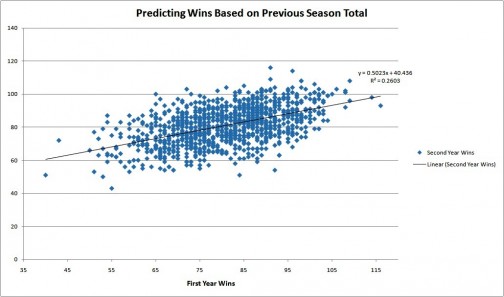With the 2011 season about to begin, here’s a reminder of how tough it is to win every year. The following graph shows how team wins changed year to year, looking at consecutive 162 games seasons (I left out any pair of seasons where work stoppages caused less than a 162 game schedule to be played). Click for a larger view.
It turns out one half of the previous year’s win total plus 40 is an okay estimate. The regression equation pulls all teams toward 81 wins, which needs to be the result of course. Baseball is a zero sum game in terms of wins. If some team is going to win five more games in a season, those five wins need to come out of another team’s total.
Note that there is a lot of noise in the data, hence the low R-squared. The biggest outliers are the 1999 Diamondbacks who went from 65 wins to 100, and the 1998 Marlins who dropped from 92 wins to 54. Note, too, the high end of the scale, team that win over 105 games. Six of those teams beat the regression equation the next year, two are about right on, and two do worse than the regression predicts. That much talent on a team tends to hold up.
The reason for much of the noise is that team do try to fight against this regression. Long term success means not resting on your laurels, but constantly trying make small improvements to keep a team competitive. (The Braves serve as a great example of this during their 1990s run of playoff appearances. They seemed to make one significant change every year, upgrading a position that wasn’t bad, but could be made better.) The following table shows how organizations fared in beating the regression equation (accumulating more wins than the regression formula predicts):
| TeamName | Seasons | Beat | PctBeat |
| Yankees | 42 | 29 | 69 |
| Dodgers | 41 | 25 | 61 |
| Reds | 41 | 24 | 58.5 |
| Braves | 41 | 24 | 58.5 |
| Cardinals | 41 | 24 | 58.5 |
| Blue Jays | 28 | 16 | 57.1 |
| Athletics | 42 | 24 | 57.1 |
| Red Sox | 42 | 24 | 57.1 |
| Giants | 39 | 22 | 56.4 |
| Phillies | 41 | 23 | 56.1 |
| Twins/Senators | 42 | 23 | 54.8 |
| Angels | 42 | 22 | 52.4 |
| Tigers | 42 | 22 | 52.4 |
| Marlins | 14 | 7 | 50 |
| Pirates | 41 | 20 | 48.8 |
| Astros | 41 | 20 | 48.8 |
| Orioles | 42 | 20 | 47.6 |
| Mets | 41 | 19 | 46.3 |
| White Sox | 42 | 19 | 45.2 |
| Royals | 34 | 15 | 44.1 |
| Mariners | 28 | 12 | 42.9 |
| Indians | 40 | 17 | 42.5 |
| Diamondbacks | 12 | 5 | 41.7 |
| Cubs | 41 | 16 | 39 |
| Padres | 34 | 13 | 38.2 |
| Rockies | 14 | 5 | 35.7 |
| Rangers/Senators | 42 | 15 | 35.7 |
| Nationals/Expos | 34 | 12 | 35.3 |
| Brewers/Pilots | 33 | 10 | 30.3 |
| Rays/Devil Rays | 12 | 2 | 16.7 |
Not surprisingly, the Yankees and Dodgers, with their great resources over the years, were consistently able to do better than expected. The Athletics, one of the teams that was an early adopter of sabermetrics, also ranks high.
At the other end, there are a bunch of expansion teams and the Cubs. You can see just how poorly the Rays front office performed until recently, the two plus years coming in 2008 and 2010. There’s no excuse for the Cubs. They have a huge fan base and a sold out park. They really should be up there with the Yankees and Dodgers. No wonder they haven’t reached the World Series since 1945.


